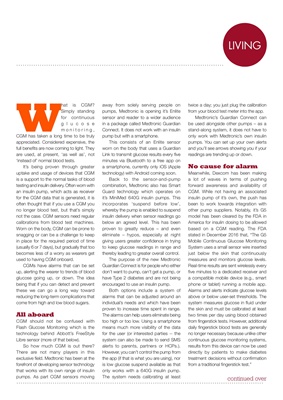
KITLIVING
continued over
W
hat is CGM?
Simply standing
for continuous
glucose
monitoring,
CGM has taken a long time to be truly
appreciated. Considered expensive,
only with increased usage by both HCPs
becoming familiar with the technology
as well as diabetics wearing it, the full
benefits are now coming to light. They
are, at present, 'as well as', not 'instead
of' normal blood tests.
It's being proven through greater
uptake and usage of devices that
CGM is a support to the normal talksof
blood testing and insulin delivery. Often
associated with wearing an insulin pump,
which act as receivers for the CGM data
that is generated, it is often thought that
if you use a CGM you no longer blood
test, but that's simply not the case. CGM
sensors need regular calibrations from
blood test machines. Worn on the body,
CGM can be prone to snagging or can
be a challenge to keep in place for the
required period of time (usually 6 or 7
days) but over time that too becomes less
of a worry as users get used to having
CGM onboard.
CGMs have a set of alarms that can
be set up, alerting the wearer to trends
of blood glucose going up, or down.
The idea being that if you can detect
and prevent these we can go a long
way toward reducing the long-term
complications that come from high and
low blood sugars.
All aboard
CGM should not be confused with
Flash Glucose Monitoring which is the
technology behind Abbott's FreeStyle
Libre sensor (more of that below).
So how much CGM is out there? There
are not many players in this exclusive field.
Medtronic has been at the forefront of
developing sensor technology that works
with its own range of insulin pumps. As
part of the move of CGM sensors away
from solely serving people on pumps,
Medtronic is opening it's Enlite sensor and
reader to a wider audience in a package
called Medtronic Guardian Connect that
does not work with an insulin pump but
with a smartphone.
This consists of an Enlite sensor
worn on the body that uses a Guardian
Link to transmit glucose results every five
minutes via Bluetooth to a free app on
a smartphone, currently only iOS (Apple
technology) with Android coming soon.
Back to the sensor-and-pump
combination, Medtronic also has Smart
Guard technology which operates on
it's MiniMed 640G insulin pumps. This
incorporates 'suspend before low',
whereby the pump is enabled to suspend
insulin delivery when sensor readings go
below an agreed level. This has been
proven to greatly reduce - and even
eliminate - hypos, especially at night
giving users greater confidence in trying
to keep glucose readings in range and
thereby leading to greater overall control.
The purpose of the new Medtronic
Guardian Connect is for people who either
don't want to pump, can't get a pump, or
have Type 2 diabetes and are not being
encouraged to use an insulin pump.
Both options include a system of
alarms that can be adjusted around an
individuals needs and which have been
proven to increase time spent in range.
The alarms can help users eliminate being
too high or too low. Using a smartphone
means much more visibility of the data
for the user (or interested parties -- the
system can also be made to send SMS
alerts to parents, partners or HCPs.).
However, you can't control the pump from
the app (if that is what you are using), nor
is low glucose suspend available as that
only works with a 640G insulin pump.
The system needs calibrating at least
twice a day; you just plug the calibration
from your blood test meter into the app.
Medtronic's Guardian Connect can
be used alongside other pumps - as a
stand-along system, it does not have to
only work with Medtronic's own insulin
pumps. You can set up your own alerts
and you'll see arrows showing you if your
readings are trending up or down.
No cause for alarm
Meanwhile, Dexcom has been making
a lot of waves in terms of pushing
awareness and availability of CGM
forward. While not having an associated
insulin pump of it's own, the push has
been to work towards integration with
other pump suppliers. Notably, it's G5
model has been cleared by the FDA in
America for insulin dosing to be allowed
based on a CGM reading. The FDA
stated in December 2016 that, "The G5
Mobile Continuous Glucose Monitoring
System uses a small sensor wire inserted
just below the skin that continuously
measures and monitors glucose levels.
Real-time results are sent wirelessly every
five minutes to a dedicated receiver and
a compatible mobile device (e.g., smart
phone or tablet) running a mobile app.
Alarms and alerts indicate glucose levels
above or below user-set thresholds. The
system measures glucose in fluid under
the skin and must be calibrated at least
two times per day using blood obtained
from fingerstick tests. However, additional
daily fingerstick blood tests are generally
no longer necessary because unlike other
continuous glucose monitoring systems,